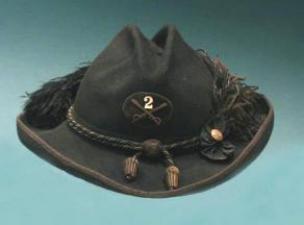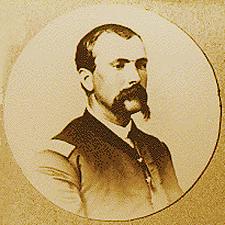|
Captain Rufus Smith
Rufus W. Smith
2nd Regt. Massachusetts Cavalry
Company F, Company A
1863 - 1864 |
 |
 |
Rufus W. Smith was born in 1823 in the State of Maine. While still a young man, he made his way to the West, eventually settling in San Francisco. Rufus must have been patriotically
inclined as he served as a member of a
local Militia unit called the San Francisco Light Guard.
In 1861 when hostilities erupted in the East, Smith watched as tensions increased
between members of opposing groups even out west in California. He and his friends from the
California Light Guard resigned their commissions to enlist in the Federal Army,
only to learn that these California troops would serve garrison duty on the West
Coast, pacifying Indians thousands of miles from the Civil War.
When, in October of 1862, Governor John Andrew of Massachusetts approved a plan to furnish a cavalry company
of one hundred Californians (who would be credited toward the recruitment quota of
Massachusetts) Smith was likely one of the 500 men in the first wave of volunteers, but
was not among the 100 mustered into service. He watched as his associates, now
known as "The California Hundred" departed on December 10, 1862 for the theater
of War. Little did he realize that in less than two years, he would ride to his
death leading a Cavalry charge at the head of that same "Hundred" after replacing Captain J. Sewall Reed who had been killed only weeks before.
The enthusiasm seen in the raising of the California Hundred encouraged others to offer to raise companies under the same agreement with
Massachusetts. In March, 1863 Rufus Smith was commissioned Lieutenant of F
Company and, along with 386 other enlisted men and thirteen officers mustered into service as
the four cavalry companies known as the California Battalion. They set sail aboard the steamer Constitution, crossed the Isthmus of Panama
by rail and boarded another steamer bound for New York City.
Lt. Smith's immediate superior was Captain Charles S. Eigenbrodt with whom he was to face danger and hardship over the coming two years as the 2nd Mass earned a war record unsurpassed by any other Federal Cavalry unit. When the regiment was to finally muster out
of service in 1865, only 188 of the 501 enlistees would be present for duty. Although some were promoted to command in other units, the rest would be
casualties: killed while fighting, lost to wounds or and disabilities or
victims of Confederate prison
camps.
Under the leadership of Colonel Charles Russell Lowell, recently of General George McClellan's staff, Lt. Smith was garrisoned outside Washington
D.C. where his company stood picket at the outposts and scouted in front of the forts defending the national capital. The rough-and-ready Californians
used their time getting acquainted with the citified New Englanders who were their newly found Cavalry associates.
During the next six months, Lt. Smith and F Company were armed with their
sabers, sidearms, and a mix of Burnside and Sharps carbines. While in Northern
Virginia they were constantly engaged with Confederate Colonel John Mosby's Partisan Rangers. As a Cavalry Lieutenant, he was involved in
numerous scouts, expeditions, and skirmishes including South Ana Bridge, Hanover Court House, Ashby's Gap, Fairfax Court House, and Leesburg,
Virginia.
On August 24,
1863, Lt. Smith's F Company was escorting 100 horses past Gooding's Tavern when they were surprised by Mosby
and about 30 of his men. A hot skirmish took place and two men from both sides were killed, five 2nd Mass troopers were taken prisoner and 75 horses
were lost. But the California Yankees had helped even the score by seriously wounding
Col. Mosby in the side and thigh.
Sometime in the summer, the Captain of F was detached or detailed and on September 1, 1863 Lt. Smith is noted as having
taken command.
In February, 1864 two companies of the 2nd Mass Cavalry were surprised by Mosby and a large Rebel cavalry
force and Captain J. Sewall Reed, the original founder of the California
Hundred was killed. Lt. Smith's courageous service must have drawn the attention of his superiors,
because on March 29, 1864 he was promoted to lead A Company, the "California Hundred," replacing Capt. Reed.
Under Captain Smith's command, A Company held the honor of "right of the line" as Confederate General Jubal Early threatened Washington D.C.
Considerable action took place until Early was repulsed, with heavy rear guard skirmishing as the Southern forces were driven back across the Potomac.
As Summer passed and the cooler days of Autumn arrived, Captain Smith and
A Company found action at Snicker's Gap, Strasburg, Winchester, Opequan Creek, Berryville, Front Royal, Fisher's Hill, Port Republic, Waynesborough
and Tom's Brook (a.k.a. Woodstock Races).
They were now armed with their long awaited Spencer repeating carbines and enjoyed considerable advantage in
firepower over their Confederate counterparts. At Halltown, in August, Captain Smith saw his long time friend, Captain
Charles S. Eigenbrodt shot from his horse while leading a charge against the enemy. The following day another friend, Lt. Charles E. Meader and his
mounted troopers carried enemy works where hand to hand fighting ensued among the Confederate infantry and Lt. Meader was killed.
Captain Smith had remained unscathed, but on
the morning of October 19, 1864, Captain Smith rode on his last scout across the river to "feel" for the enemy in the hills beyond Cedar
Creek. General Sheridan, was away at Winchester, 12 miles behind the lines. As the men fed their horses and got their own breakfasts, they began to hear
the mutter of gunfire at the left of the Union line. No one gave it much thought as Union General Wright was expected to make a
reconnaissance in force that morning to press Early's rebel army. But the popping of picket
fire grew to a crescendo and was soon joined by artillery pounding and the crash of musketry. Confederate forces commanded by
General Early surprised the Federal 6th and 19th Corps as they burst from the pre-dawn fog causing the federal line to
collapse and retreat in confusion. A complete Confederate rout seemed in the making.
For the 2nd Mass Cavalry, all thoughts of a departing on a scout vanished when the fighting erupted. After mounting up, they made a wide sweep behind
the unsettled Union lines and struck the Confederate right in a desperate effort to slow their advance. They then joined small bands of infantry from
the 6th Union corps in attempting to hold points of defense and stem the onslaught of the Confederate forces. Colonel Charles Lowell led a mounted
charge against the oncoming rebel infantry where his horse was shot from beneath him, the thirteenth in the last three months. Continuing on foot, he
received a mortal wound to the chest, purchasing precious time with his life, and those of his troopers.
On a neighboring field, Captain Smith prepared to again lead A Company against the Confederate line. He waited until the advancing force was close
enough that they would have time for only one volley into the oncoming Cavalry. Then came the familiar command "Forward! Trot! Gallop! Charge!"
and away went A Company with sabers flashing. The two lines crashed together and while amidst the Confederate infantry, Captain Smith was shot from his
horse and died of his wound the following day.
Major D. W. C. Thompson of the California Cavalry Battalion offers his eulogy to Captain Smith.
"Early in the day, at the hard-fought battle of
Cedar Creek, October 19, 1864, Captain Rufus W. Smith, formerly commander of the Light Guard of San Francisco, was killed while in command of his
squadron, endeavoring to check the then successful advance of the enemy. This brave officer left home, friends, and business to serve with the
battalion, and after participating in many engagements lost his life on the field of Sheridan's greatest victory."
Neither Captain Smith nor Colonel Lowell would see the storied arrival on the field of General Sheridan atop
his black steed "Rienzi", only moments after the charges by the 2nd Mass Cavalry. Sheridan's presence rallied the troops, the momentum of battle
shifted to the Federals and the day was eventually won.
Along with the brave efforts of many officers and soldiers, the sabers of the Californians helped
purchase the precious time needed to turn the tide of the Battle of Cedar Creek.
Ah! Never shall the land forget
How gushed the life-blood of her brave,
Gushed warm with hope and courage yet
Upon the soil they fought to save.
Biography courtesy of Mike Sorenson
| 


